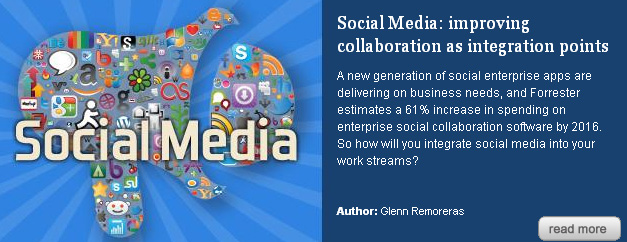According to Forrester research, organizations will increase their spending on enterprise social collaboration software at a compound annual growth rate of 61% through 2016. Forrester estimates enterprise social software will become a $6.4 billion market in 2016. This is based on their assumption that a new generation of social enterprise apps is, and will be, delivering on business needs. If this is the trend today and more so in the near future, how do you the plan to integrate social media to your work streams?
There are many integration points and it all depends on the needs of the business. Those needs can be classified into two types: (1) mass engagements: involvement of wider audience with open-ended boundaries; and (2) internal and external collaboration: engagement of specific audience, with defined boundaries.
In this article, we will focus on improving collaboration as integration points.
Collaboration through social tools usually entails the implementation of a collaborative decision management solution that encourages change in the way businesses collaborate to facilitate innovations. Saying that, two critical factors emerge:
(1) change in culture, ie, the way employees in a company collaborate, and
(2) the need to select and adopt an effective, collaborative-type tool
Companies that use collaboration as an integration point to adopting social tools face the following challenges:
(a) How do we get beyond e-mail, traditional meetings, conference calling, etc, to these new social platforms that include an industrial-strength social network?
(b) How do we change the way we work?
(c) How do we integrate social tools in our enterprise work stream?
(d) How do we become more innovative as a company because of it?
The answer is not Facebook nor Twitter – not for this type of business need. There are, however, applications for these purposes available in the market. They are referred to as collaborative decision management applications that provide functionalities like wikis, blogs, project management, community building, idea creation, etc.
Implementing a social tool for collaboration is just the first step, or I should say, the easy step. To get employees to use it collectively enough to change the way they collaborate is the much bigger challenge. Adoption of social tools in the workplace setting requires more than compliance and a management mandate. It is about culture transformation from within and for all employees, from top to bottom.
So, what’s the point?
Today, if an employee has an idea, he or she goes to their boss to discuss it, or goes to the board to present it as a proposal, or sends an idea narrative by email. Consider the alternative of posting ideas as wikis, and letting everyone else read, comment and even change them.An effective approach is a grassroots adoption through structured learning experiences, involving adoption champions from different levels of the organization. The communication and implementation of the grassroots approach must be focused on the benefits to the users first, and promotion of the value creation for the company next.
It’s easier to convince employees to change the way they work if they understand that this will make their job easier.





 To mitigate risk the first thing that companies should establish in an Enterprise 2.0 initiative is the governance strategy. Some companies, for example, encourage its employees to participate in mainstream social media. They support employees who write blogs internally and externally; however, they have to follow a set code of conduct. A common component of these policies is the “don’t tell secrets policy”. Companies want to safeguard proprietary and confidential information. Go to
To mitigate risk the first thing that companies should establish in an Enterprise 2.0 initiative is the governance strategy. Some companies, for example, encourage its employees to participate in mainstream social media. They support employees who write blogs internally and externally; however, they have to follow a set code of conduct. A common component of these policies is the “don’t tell secrets policy”. Companies want to safeguard proprietary and confidential information. Go to 
 In the world of Information Technology, many buzz words and phrases are created everyday. It’s hard to keep up. It’s not only because too many of these words are thrown at us everyday but also because their definitions often change rapidly. One of these phrases is Web 2.0 – which I talked about in my
In the world of Information Technology, many buzz words and phrases are created everyday. It’s hard to keep up. It’s not only because too many of these words are thrown at us everyday but also because their definitions often change rapidly. One of these phrases is Web 2.0 – which I talked about in my  In my
In my